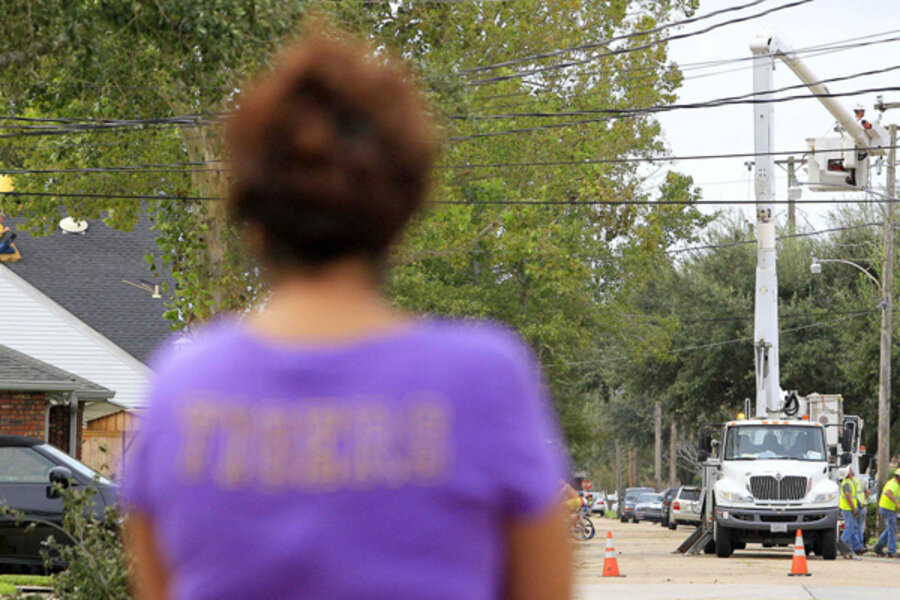Remnants of Issac head for the Midwest, recovery slow in the Gulf
Loading...
| New Orleans
As the remnants of Hurricane Isaac pushed their way up the Mississippi valley on Saturday, spinning off severe thunderstorms and at least four tornadoes, some on the Gulf Coast were impatient with the pace of restoring power days after the storm dragged through the region.
While New Orleans streets were bustling again and workers were returning to offshore oil rigs, thousands of evacuees couldn't return home to flooded low-lying areas of Louisiana and more than 400,000 sweltering electricity customers in the state remained without power.
Meanwhile, the National Weather Service said two tornadoes touched down in rural areas of north-central Illinois and at least two touched down in rural southeast Missouri. There were no reports of damage in Illinois, and Missouri officials said some power lines caught on fire.
The weather service said the storm would bring some drought relief to parts of the Mississippi and Ohio River Valleys. By midday Saturday, it had dumped up to 5 inches of rain in parts of Illinois and between 4 and 6 inches in parts of Missouri.
In Louisiana, the number without power was down from more than 900,000. However, in heavily populated Jefferson Parish near New Orleans, parish president John Young said Entergy Corp. was too slow in restoring electricity.
"I don't see boots on the ground," said Young, who complained that he has seen repair trucks sitting idle in a staging area and fielded calls from residents and business owners complaining about a lack of progress.
"We've restored about 45 percent of our customers in about a day and a half, Entergy spokesman Chanel Lagarde said Saturday. He added that crews have come in from 24 states. "In many situations, crews have driven all day and have worked their 16-hour day and have to rest for the day."
As of Saturday night, the company was reporting about 270,000 outages, most in Jefferson and Orleans parishes.
New Orleans Mayor Mitch Landrieu said he too was eager to get power back on. "Like everybody else, my patience is wearing thin," he said.
On Saturday afternoon, St. Tammany Parish officials ordered a mandatory evacuation of areas south of the Pearl River diversion canal, for fear a lock on a canal will fail. Parish authorities said the order could affect anywhere from several hundred to 2,000 residents in the rural area north of Slidell, which is across Lake Pontchartrain from New Orleans.
The U.S. Army Corps of Engineers operates the lock. Parish spokeswoman Suzanne Parsons Stymiest said the parish got permission from the corps to relieve pressure on the structure by opening a valve that will allow a controlled flow of water through it.
Parts of coastal Plaquemines Parish, where thousands were evacuated, remained under water. The National Weather Service has said Isaac dumped anywhere from 10 to 20 inches of rain on south Louisiana and south Mississippi.
In the water-logged town of Lafitte, Mayor Tim Kerner was allowing property owners and residents to return and begin cleaning up.
Meanwhile, Gulf of Mexico oil platforms were being repopulated after Isaac forced shutdown of most Gulf oil production.
People stuck inside stuffy, powerless homes were comparatively lucky. The Louisiana governor's office said more than 4,000 were in state, local or Red Cross shelters as of Saturday morning and that doesn't count others who took refuge with friends, family or in hotels.
LaPlace resident Roshonda Girrad was staying in a state-run shelter in Alexandria, 200 miles from her home. She was waiting for the chest-deep waters in her neighborhood to recede.
"The showers are horrible. The food is horrible," Girrad said. "I'm not from around here. I don't know what's going on. We're in the dark."
Isaac dumped as much as 16 inches of rain in some spots, and about 500 people had to be rescued by boat or high-water vehicles.
In New Orleans, most of the downtown area and the French Quarter had power again Saturday. The annual Southern Decadence festival, a celebration of gay culture, was underway. And the Superdome, which sustained minor damage, hosted a Saturday night football game between Tulane and Rutgers.
Republican presidential nominee Mitt Romney visited flood-ravaged communities on Friday, and President Barack Obama said he would arrive Monday — appearances this part of the country is all too familiar with after Hurricane Katrina in 2005 and the 2010 Gulf oil spill.
To the east, officials pumped and released water from a reservoir, easing the pressure behind an Isaac-stressed dam in Mississippi on the Louisiana border. The threat for the earthen dam on Lake Tangipahoa prompted evacuations in small towns and rural areas. Authorities later said they were allowing residents to return to their homes in those areas where the flood waters have since receded.
Crews intentionally breached a levee that was strained by Isaac's floodwaters in southeast Louisiana's Plaquemines Parish, which is outside the federal levee system. Parish President Billy Nungesser said the work was slow-going.
Associated Press writers Vicki Smith, Stacey Plaisance, Cain Burdeau and Janet McConnaughey in New Orleans; Heather Hollingsworth in Kansas City, Mo., and Jason Keyser in Chicago contributed to this story.







